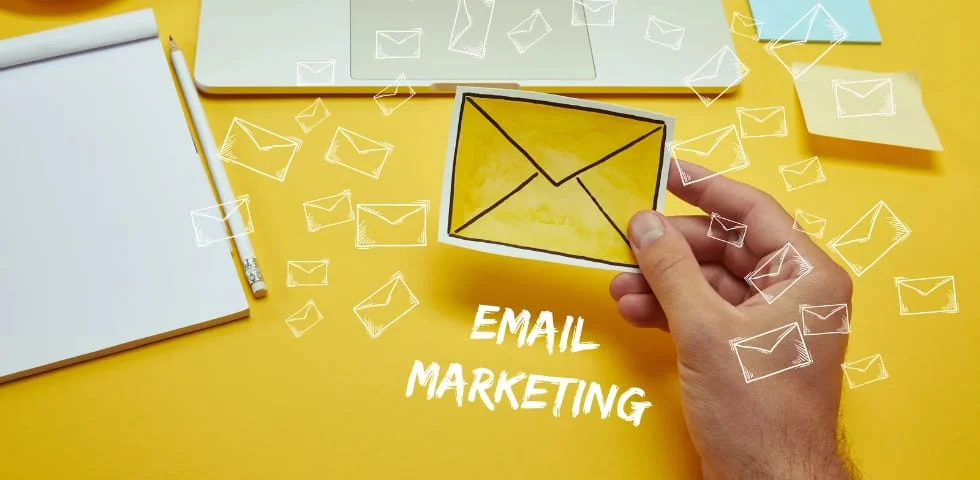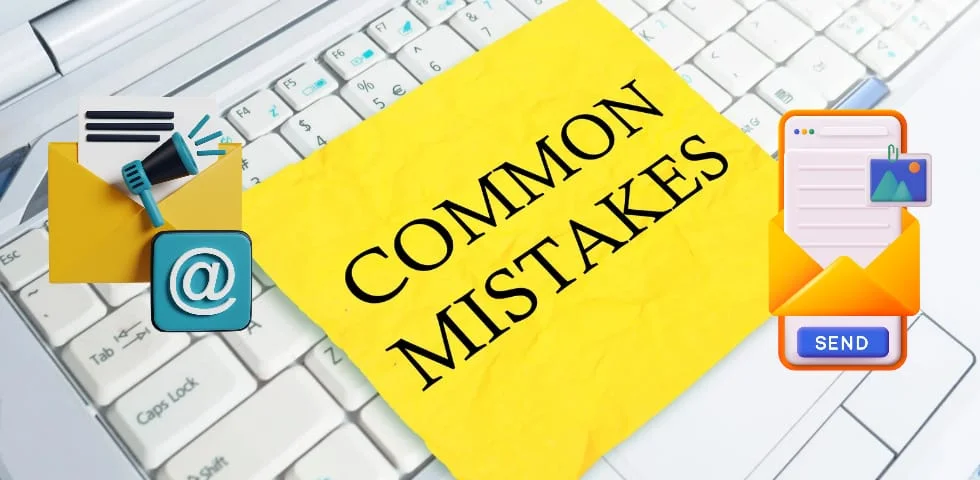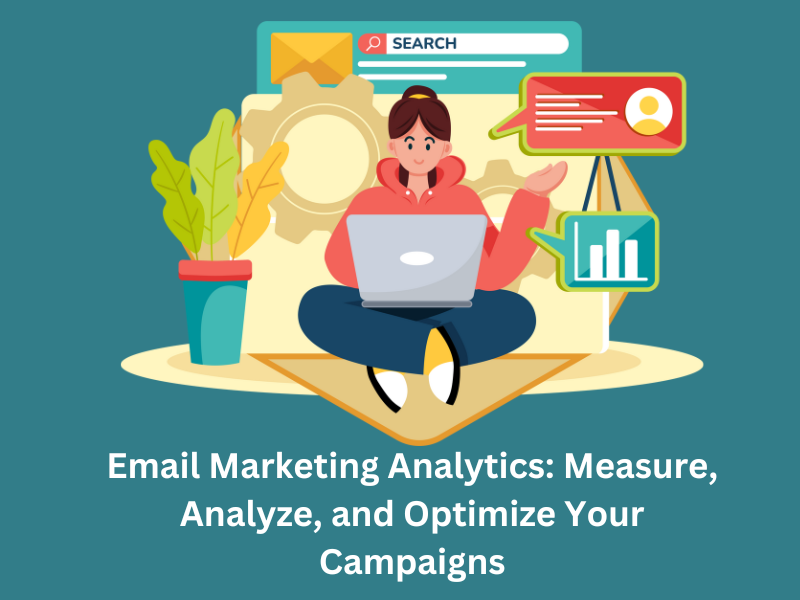Email marketing remains one of the most powerful tools in a digital marketer’s arsenal. According to recent statistics, the average ROI for email marketing is a staggering $42 for every $1 spent. This impressive figure highlights the potential impact of well-crafted email campaigns. However, simply sending emails isn’t enough. To truly harness the power of email marketing, it’s crucial to employ effective strategies that not only reach your target audience but also convert them into loyal customers.
In today’s competitive landscape, understanding the nuances of email marketing can make the difference between a campaign that merely exists and one that excels. This blog post will explore proven strategies to enhance your email campaigns, improve open and conversion rates, and effectively engage your target audience.
The Importance of Email Marketing in Digital Strategy
Email marketing holds a unique position within the digital marketing ecosystem. Unlike social media, which often relies on algorithms and ever-changing policies, email provides a direct line of communication with your audience. Here’s why email marketing is indispensable:

Email Marketing vs. Other Digital Marketing Channels
When compared to other digital marketing channels, email marketing offers several distinct advantages:
- Direct Communication: Emails go straight to the recipient’s inbox, offering a personal touch that’s hard to achieve with social media posts or banner ads.
- Ownership: Unlike followers on social media platforms, your email list is yours. You own the data, and it’s not subject to the whims of platform changes.
- High Engagement Rates: Email consistently outperforms other channels in terms of engagement metrics, including open and click-through rates.
ROI of Email Marketing
The return on investment for email marketing is one of the highest among all marketing channels. According to the Data & Marketing Association, every dollar spent on email marketing generates an average return of $42. This high ROI is due to the relatively low cost of email marketing combined with its effectiveness in driving sales and conversions.
Why Email Marketing Matters
- Building Relationships: Email marketing allows you to build and nurture relationships with your audience over time. Regular, valuable communication keeps your brand top-of-mind.
- Driving Conversions: With the right strategies, emails can effectively drive conversions. Whether it’s a sale, a download, or a signup, email remains one of the most effective channels for prompting action.
- Personalization and Segmentation: Emails can be highly personalized and segmented to address the specific needs and interests of different audience segments. This level of customization enhances engagement and effectiveness.
Crafting Compelling Email Content
Creating compelling email content is both an art and a science. It requires understanding your audience, crafting engaging subject lines, writing effective email copy, and using visuals strategically. Here’s how to get started:

Understanding Your Audience
The foundation of any successful email campaign is a deep understanding of your audience. Start by developing detailed buyer personas that include demographic information, interests, and pain points. This will help you tailor your messages to resonate with your recipients.
Writing Effective Subject Lines
The subject line is the first thing your audience sees, and it greatly influences whether your email gets opened. Here are some tips for crafting effective subject lines:
- Keep It Short and Sweet: Aim for 6-10 words or around 50 characters.
- Create a Sense of Urgency: Use time-sensitive language to encourage immediate action.
- Be Clear and Direct: Clearly convey the value of opening the email.
- Use Personalization: Incorporate the recipient’s name or other personalized details.
Examples:
- “Limited Time Offer: 20% Off Your Favorite Items”
- “Hi [Name], Don’t Miss Out on These Exclusive Tips”
Creating Engaging Email Copy
Once you’ve enticed your audience to open your email, the content needs to keep them engaged. Follow these best practices:
- Be Concise: Get to the point quickly. Long-winded emails often lose the reader’s attention.
- Focus on Benefits: Highlight the benefits your reader will gain from your offer or information.
- Use a Conversational Tone: Write as if you’re speaking directly to the reader.
- Include a Clear Call to Action (CTA): Each email should have one primary action you want the reader to take.
Example:
“Our new line of eco-friendly products is here! Enjoy a cleaner, greener home with these innovative solutions. [Shop Now]”
Using Visuals
Visual elements can significantly enhance your email’s appeal and readability. Here are some tips for using visuals effectively:
- High-Quality Images: Use professional, high-resolution images that align with your brand.
- Consistent Branding: Ensure that colors, fonts, and styles match your overall brand identity.
- Infographics and Charts: Use these to convey complex information in a digestible format.
- Mobile Optimization: Make sure your visuals are responsive and look good on all devices.
Segmenting Your Email List for Better Targeting
Email segmentation involves dividing your email list into smaller, more targeted groups. This practice allows you to send more personalized and relevant content to your subscribers, significantly improving engagement and conversion rates. Here’s how to effectively segment your email list:

What is Email Segmentation?
Email segmentation is the process of categorizing your email subscribers into distinct groups based on specific criteria. These criteria can include demographics, behavior, interests, purchase history, and more. By segmenting your list, you can tailor your messages to meet the specific needs and preferences of each group.
Segmentation Strategies
Demographics:
- Age: Tailor your content to suit different age groups.
- Gender: Customize your messages based on gender preferences.
- Location: Send region-specific offers and updates.
Behavior:
- Purchase History: Segment users based on their buying behavior and target them with relevant product recommendations.
- Email Engagement: Group subscribers by their engagement levels (e.g., frequent openers vs. inactive users).
- Website Activity: Segment users based on their interactions with your website (e.g., pages visited, time spent on site).
Interests:
- Product Preferences: Categorize users by their interest in specific products or services.
- Content Preferences: Segment based on the types of content they engage with, such as blogs, videos, or case studies.
Lifecycle Stage:
- New Subscribers: Welcome emails and introductory offers.
- Loyal Customers: Exclusive deals and loyalty rewards.
- Churned Customers: Re-engagement campaigns to win them back.
Personalization Techniques
Segmentation paves the way for highly personalized emails. Here are some techniques to personalize your emails:
- Personalized Subject Lines: Include the recipient’s name or reference their past behavior.
- Dynamic Content: Use content blocks that change based on the recipient’s segment.
- Custom Offers: Provide special offers or discounts tailored to the recipient’s preferences and past purchases.
- Personalized Recommendations: Suggest products or content based on their previous interactions.
Example:
A fitness brand might send different emails to subscribers interested in yoga versus those interested in weightlifting, offering tailored content, products, and tips for each group.
Strategies to Increase Email Open Rates
Improving your email open rates is crucial for the success of your email marketing campaigns. If your emails aren’t opened, all the effort you put into crafting compelling content goes to waste. Here are some proven strategies to boost your email open rates:

Optimal Send Times
Timing can significantly impact your email open rates. Here are some tips for finding the best times to send your emails:
- Test Different Times: Conduct A/B tests to determine when your audience is most likely to open emails.
- General Best Practices: Many studies suggest that weekdays, especially Tuesday and Thursday mornings, tend to have higher open rates.
- Consider Time Zones: If you have a global audience, segment your list by time zones to ensure emails arrive at the optimal time for each region.
Using Preheaters Effectively
The preheader text is the snippet of text that follows the subject line when an email is viewed in the inbox. It provides additional context and can entice recipients to open the email. Here’s how to use preheaters effectively:
- Complement the Subject Line: The preheater should enhance and add value to the subject line.
- Keep It Concise: Aim for around 50-100 characters.
- Incorporate a CTA: Encourage the reader to take action or provide a teaser of the content inside.
Example:
- Subject Line: “Exclusive Offer Just for You!”
- Preheater: “Get 25% off your next purchase. Limited time only.”
A/B Testing
A/B testing involves sending two variations of an email to small segments of your list to see which performs better. Here’s how to conduct effective A/B tests:
- Test One Element at a Time: Focus on a single element, such as the subject line, preheader, or send time, to determine what impacts open rates.
- Use Meaningful Sample Sizes: Ensure your test segments are large enough to provide statistically significant results.
- Analyze and Implement Results: Apply the winning variation to the rest of your email list.
Examples of Elements to Test:
- Subject Line Length and Style: Short vs. long, casual vs. formal
- Personalization: Including the recipient’s name vs. not
- Emojis: Using emojis in the subject line vs. not
Techniques to Boost Email Conversion Rates
Once you’ve successfully increased your email open rates, the next goal is to convert those opens into tangible actions, such as purchases, sign-ups, or downloads. Here are some effective techniques to boost your email conversion rates:

Clear and Compelling CTAs
A strong call to action (CTA) is essential for driving conversions. Here’s how to craft effective CTAs:
- Be Direct: Clearly state what you want the reader to do (e.g., “Shop Now,” “Download the Guide,” “Sign Up Today”).
- Create Urgency: Use time-sensitive language to encourage immediate action (e.g., “Limited Time Offer,” “Act Now”).
- Make It Stand Out: Use buttons, bold colors, and large fonts to make your CTA visually distinct.
- Limit Choices: Too many options can overwhelm readers. Focus on one primary CTA per email.
Example:
“Exclusive Offer: Get 30% Off Your Next Purchase! [Shop Now]”
Landing Page Optimization
The transition from your email to your landing page should be seamless. Here are some tips for optimizing your landing pages:
- Consistency: Ensure that the design, messaging, and offer on the landing page match the email content.
- Simplicity: Keep the landing page clean and focused on the desired action.
- Mobile-Friendly: Make sure the landing page is optimized for mobile devices.
- Fast Loading: Ensure quick load times to prevent user drop-off.
Example:
If your email promotes a special discount, the landing page should prominently display the same discount and an easy-to-use checkout process.
Incorporating Social Proof
Social proof, such as testimonials, reviews, and case studies, can significantly boost your email’s credibility and conversion rates. Here’s how to use social proof effectively:
- Testimonials: Include quotes from satisfied customers.
- Case Studies: Highlight success stories that demonstrate the effectiveness of your product or service.
- User-Generated Content: Feature photos, videos, or reviews from your customers.
Example:
“See why our customers love us: ‘This product changed my life!’ – Jane Doe [Read More Reviews]”
Analyzing and Measuring Email Campaign Success
To continuously improve your email marketing efforts, it’s crucial to analyze and measure the performance of your campaigns. Here are the key metrics to track and tools to use:

Key Metrics to Track
Open Rates:
- What It Measures: The percentage of recipients who open your email.
- Why It Matters: Indicates the effectiveness of your subject lines and send times.
Click-Through Rates (CTR):
- What It Measures: The percentage of recipients who clicked on a link within your email.
- Why It Matters: Shows how engaging your email content is and how well your CTAs are performing.
Conversion Rates:
- What It Measures: The percentage of recipients who completed the desired action (e.g., making a purchase, filling out a form).
- Why It Matters: Indicates the overall effectiveness of your email in driving desired outcomes.
Bounce Rates:
- What It Measures: The percentage of emails that were not delivered to the recipient’s inbox.
- Why It Matters: Helps you assess the quality of your email list and your deliverability.
Unsubscribe Rates:
- What It Measures: The percentage of recipients who unsubscribed from your email list.
- Why It Matters: Provides insights into how well your content is meeting audience expectations.
Spam Complaint Rates:
- What It Measures: The percentage of recipients who marked your email as spam.
- Why It Matters: A high rate could indicate issues with email content or list quality.
Tools for Analysis
Email Marketing Platforms:
- Mailchimp: Comprehensive analytics for tracking opens, clicks, and conversions.
- Constant Contact: Detailed reports on engagement and performance metrics.
- Sendinblue: In-depth analytics and A/B testing features.
Analytics and Reporting Tools:
- Google Analytics: Track email traffic and conversions on your website.
- HubSpot: Integrated analytics for email campaigns and overall marketing performance.
- Litmus: Provides insights into email performance and deliverability.
Adjusting Your Strategy Based on Data
Use the data you collect to make informed decisions about your email marketing strategy:
- Refine Subject Lines: Experiment with different styles and lengths based on open rate data.
- Optimize Send Times: Adjust your send times to align with when your audience is most active.
- Improve Content and CTAs: Use click-through and conversion data to tweak your email copy and calls to action.
- Segment More Effectively: Analyze engagement metrics to create more targeted segments.
Example:
If you notice that emails sent on Tuesdays have higher open rates, adjust your schedule to prioritize sending on that day.
Trends in Email Marketing for 2024
Staying ahead of the latest trends in email marketing is essential for maintaining the effectiveness of your campaigns. As we move into 2024, several emerging trends are set to shape the landscape of email marketing. Here’s what to watch out for:

Automation and AI
Automation and artificial intelligence (AI) are transforming the way marketers approach email campaigns. Here’s how these technologies can enhance your email marketing efforts:
- Personalized Content: AI can analyze subscriber behavior to send highly personalized content, increasing engagement and conversion rates.
- Automated Workflows: Automation tools can streamline your email marketing processes, from onboarding new subscribers to sending out follow-up emails based on user actions.
- Predictive Analytics: AI can predict future behaviors and trends, helping you make data-driven decisions about your email marketing strategy.
Example:
Using AI to recommend products based on past purchase behavior and browsing history, leading to more relevant and personalized emails.
Interactive Emails
Interactive emails are becoming increasingly popular as they engage recipients in a more dynamic way. Here are some interactive elements to consider:
- Gamification: Incorporate games, quizzes, or challenges within your emails to make them more engaging.
- Surveys and Polls: Embed surveys or polls to gather feedback and increase interaction.
- Interactive Images and Videos: Use clickable images and embedded videos to create a more engaging experience.
Example:
An email with a built-in quiz that helps users determine which product best suits their needs, increasing both engagement and the likelihood of conversion.
Privacy and Data Protection
With increasing concerns around data privacy, complying with regulations such as GDPR and CCPA is more important than ever. Here’s how to ensure your email marketing is compliant:
- Transparent Data Practices: Clearly communicate how you collect, store, and use subscriber data.
- Opt-In Forms: Ensure that your subscribers explicitly consent to receiving emails from you.
- Unsubscribe Options: Make it easy for subscribers to opt out if they choose to.
Example:
Including a privacy statement in your email footer that explains how subscriber data is used and providing an easy-to-find unsubscribe link.
Common Mistakes to Avoid in Email Marketing
While effective email marketing can yield impressive results, several common mistakes can hinder your efforts. Avoiding these pitfalls is essential to ensure your campaigns achieve their full potential:

Overlooking Mobile Optimization
In today’s mobile-first world, failing to optimize your emails for mobile devices can significantly impact engagement rates. Here’s what to consider:
- Responsive Design: Ensure your emails look good on all devices by using responsive design templates.
- Short Subject Lines: Mobile screens often display fewer characters, so keep subject lines concise.
- Readable Fonts: Use legible font sizes and styles that are easy to read on smaller screens.
- Clickable Buttons: Make sure CTAs and links are easy to tap on a touchscreen.
Example:
An email that looks great on a desktop but is difficult to read on a smartphone can result in higher bounce rates and lower engagement.
Ignoring Analytics
Analytics provide valuable insights into the performance of your email campaigns. Ignoring these metrics means missing out on opportunities to improve. Here’s what to track:
- Open Rates: To gauge the effectiveness of your subject lines and timing.
- Click-Through Rates: To measure engagement with your content.
- Conversion Rates: To assess the overall success of your campaigns in driving desired actions.
- Bounce Rates: To understand list quality and deliverability issues.
Example:
Regularly review and analyze your email metrics to identify trends and areas for improvement, adjusting your strategy accordingly.
Sending Too Frequently or Infrequently
Finding the right balance in your email send frequency is crucial. Here’s how to avoid sending too often or too rarely:
- Set Expectations: Let subscribers know how often they can expect to hear from you when they sign up.
- Monitor Engagement: Pay attention to engagement metrics. High unsubscribe rates may indicate you’re sending too frequently, while low engagement could suggest you’re not sending enough.
- Segment and Personalize: Tailor your frequency based on subscriber preferences and behavior.
Example:
Overwhelming your audience with daily emails can lead to high unsubscribe rates, while infrequent emails might result in lower brand recall and engagement.
Tools and Software for Effective Email Marketing
Choosing the right tools and software is essential for managing and optimizing your email marketing campaigns. Here are some of the best options available:

Email Marketing Platforms
Mailchimp
- Features: Easy-to-use drag-and-drop email builder, robust analytics, A/B testing, automation workflows.
- Best For: Small to medium-sized businesses looking for an all-in-one solution.
- Pros: User-friendly interface, extensive integration options, free tier available.
- Cons: Pricing can be high for larger lists, limited customization on lower tiers.
Constant Contact
- Features: Email templates, social media integration, event marketing tools, automation features.
- Best For: Businesses that need a comprehensive marketing platform.
- Pros: Excellent customer support, intuitive interface, comprehensive feature set.
- Cons: More expensive than some other options, limited advanced automation.
Sendinblue
- Features: Email marketing, SMS campaigns, marketing automation, CRM integration.
- Best For: Businesses looking for a cost-effective solution with powerful automation features.
- Pros: Affordable pricing, versatile platform, strong automation capabilities.
- Cons: Learning curve for advanced features, less intuitive interface.
Automation Tools
HubSpot
- Features: Email marketing, CRM, marketing automation, lead tracking, analytics.
- Best For: Medium to large businesses that need a robust marketing and sales platform.
- Pros: Comprehensive suite of tools, excellent reporting, strong CRM integration.
- Cons: High cost, steep learning curve for new users.
Active Campaign
- Features: Email marketing, marketing automation, sales automation, CRM.
- Best For: Businesses seeking advanced automation and CRM features.
- Pros: Powerful automation capabilities, flexible pricing, extensive customization.
- Cons: Complex interface, higher pricing for advanced features.
Analytics and Reporting Tools
Google Analytics
- Features: Tracks website traffic, user behavior, conversion rates, and more.
- Best For: Businesses looking to integrate website and email marketing analytics.
- Pros: Free to use, extensive features, customizable reports.
- Cons: Requires setup and configuration, can be complex for beginners.
Litmus
- Features: Email testing, analytics, and optimization tools.
- Best For: Businesses needing detailed email performance insights and testing.
- Pros: Comprehensive testing capabilities, detailed analytics, integration with popular email platforms.
- Cons: Expensive, particularly for small businesses.
Email Design and Testing Tools
Canva
- Features: Graphic design tool with templates for email headers, images, and more.
- Best For: Businesses that need to create visually appealing email content.
- Pros: User-friendly, extensive template library, free tier available.
- Cons: Limited advanced design features.
Testi
- Features: Email testing for deliverability, rendering, and spam score analysis.
- Best For: Businesses needing to ensure their emails render correctly across devices and email clients.
- Pros: Detailed testing reports, easy to use, comprehensive testing options.
- Cons: Subscription-based pricing.
Conclusion
Email marketing is a powerful tool that, when used effectively, can significantly boost engagement, conversions, and customer loyalty. By understanding the importance of email marketing, crafting compelling content, segmenting your audience, and employing strategies to improve open and conversion rates, you can create impactful email campaigns that drive real results.
Staying updated with trends such as automation, AI, and interactive emails, while avoiding common pitfalls like neglecting mobile optimization and ignoring analytics, will further enhance your email marketing efforts. Leveraging the right tools and software ensures you can efficiently manage and optimize your campaigns, making the most of your marketing resources.
By implementing the strategies and best practices discussed in this post, you can build a strong email marketing strategy that not only reaches but also converts your target audience. Remember, the key to successful email marketing lies in continuous learning, testing, and adapting to meet the ever-evolving needs of your audience.










